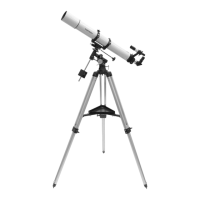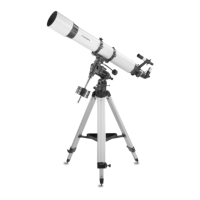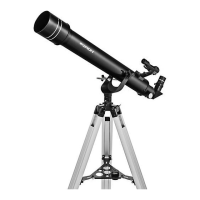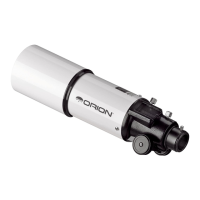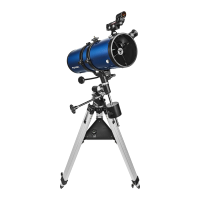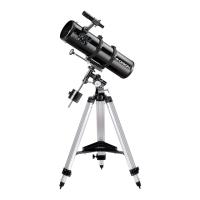10
you do not know the latitude and longitude coordinate of your
viewing location, consult an atlas or geographical map of your
area. Press ENTER to confirm your coordinates.
Note: Latitude and longitude coordinates must be entered
in degrees and arcminutes. If your map or atlas gives
coordinates in decimal values (i.e. latitude = 36.95 N) you
must convert into degrees and arcminutes (i.e. latitude
36.95 N = latitude 36°57’ N).
7. Enter the time zone in which you are observing in hours
(see Appendix D), using the scroll keys and numeric key-
pad (+ for east of Prime Meridian, - for west of Prime
Meridian). Press ENTER to confirm your choice.
8. Enter the date in the following format mm/dd/yyyy using the
numeric keypad. Press ENTER to confirm your choice.
9. Enter your current local time using the 24 hour time mode
(example: 2:00PM = 14:00). Press ENTER to view the time
you entered. If the time is incorrect, press ESC to go back
to the previous screen. If the time is correct, press ENTER
again to proceed to the next step.
10. Press ENTER if you are currently on Daylight Savings
time. Use the scroll button to scroll down to “NO” and press
ENTER if you are not on Daylight Savings Time.
The Atlas EQ-G is now ready to begin the alignment proce-
dure.
Note: if a mistake was entered into the Atlas EQ-G hand
control during the initial setup, press the ESC key to go
back to the previous menu.
Aligning the Atlas EQ-G
In order for the Atlas EQ-G to accurately locate and point to
objects in the sky, it must first be aligned on known positions
(stars) in the sky. With the supplied information, the mount
can replicate a model of the sky and the movements of astro-
nomical objects.
There are three ways to align the Atlas EQ-G depending on
your demand for accuracy. If you are using the Atlas EQ-G for
the first time, we recommend you begin with the three-star
alignment. In most cases, a three star alignment produces
the most accurate alignment among the three methods. The
description below will lead you through a step-by-step proce-
dure on how to perform the three-star alignment.
Note: Before performing any of the alignment methods, be
sure that your finderscope is well aligned with the telescope
tube.
Three-Star Alignment
1. Access the alignment screen and select “3-Star Align”
using the scroll buttons. Press ENTER to confirm your
choice.
2. The Atlas EQ-G will provide a list of stars available in
your current sky for you to choose as the first alignment
star. Choose a star you are familiar with using the scroll
buttons. Press ENTER to confirm your choice. The Atlas
EQ-G will start slewing the telescope towards the chosen
object. When the telescope stops slewing, adjust its posi-
tion using the the directional buttons until the chosen star
is centered in the crosshairs of the finderscope. Now look
in the eyepiece and adjust the position of the telescope
(using the directional buttons) so that the chosen star is
centered in the field of view of the eyepiece. Press ENTER
to confirm the star is centered.
Note: The slewing speed can be adjusted by pressing the
RATE button. Choose a desired rate between 0 (slowest)
and 9 (fastest).
Note: The Atlas EQ-G will make a “beep” sound once it
has finished slewing to an object. Do not try to adjust the
telescope before you hear the “beep” sound. The Atlas
EQ-G will only respond to the ESC button while slewing
(which stops the slewing).
3. The Atlas EQ-G will provide a list of stars that can be used
as the second alignment star. Choose a star using the
scroll buttons and press ENTER to confirm your choice.
Repeat the centering procedure for the second alignment
star using the directional buttons and press ENTER to
confirm alignment.
4. The Atlas EQ-G will once again provide a list of stars that
can be used as the third alignment star. Choose a star
using the scroll buttons and press ENTER to confirm your
choice. Once again, repeat the centering procedure for the
third alignment star and press ENTER to confirm align-
ment.
5. Once the three alignment stars have been entered and
alignment is completed, the hand controller will display
“Alignment Successful.”
Two-Star Alignment
Two-star alignment requires only two alignment stars but may
produce lesser pointing accuracy than the three-star align-
ment. The description below will lead you on a step-by-step
procedure on how to perform the two-star alignment.
1. Access the alignment screen and select “2-Star Align”
using the scroll buttons. Press ENTER to confirm your
choice.
2. The Atlas EQ-G will provide a list of stars available in your
current sky for you to choose as the first alignment star.
Using the scroll buttons, choose a star you are familiar
with and press ENTER to confirm your choice. The Atlas
EQ-G will start slewing the telescope towards the chosen
star. When the telescope stops slewing, adjust its position
with the directional buttons until the star is centered in the
crosshairs of the finderscope. Now look in the eyepiece
and adjust the position of the telescope (using the direc-
tional buttons) so that the chosen star is centered in the
field of view of the eyepiece. Press ENTER to confirm the
star is centered.
3. The Atlas EQ-G will provide a list of stars that can be used
as the second alignment star. Choose a star using the
scroll buttons and press ENTER to confirm your choice.
Repeat the centering procedure for the second alignment
star and press ENTER to confirm alignment.
